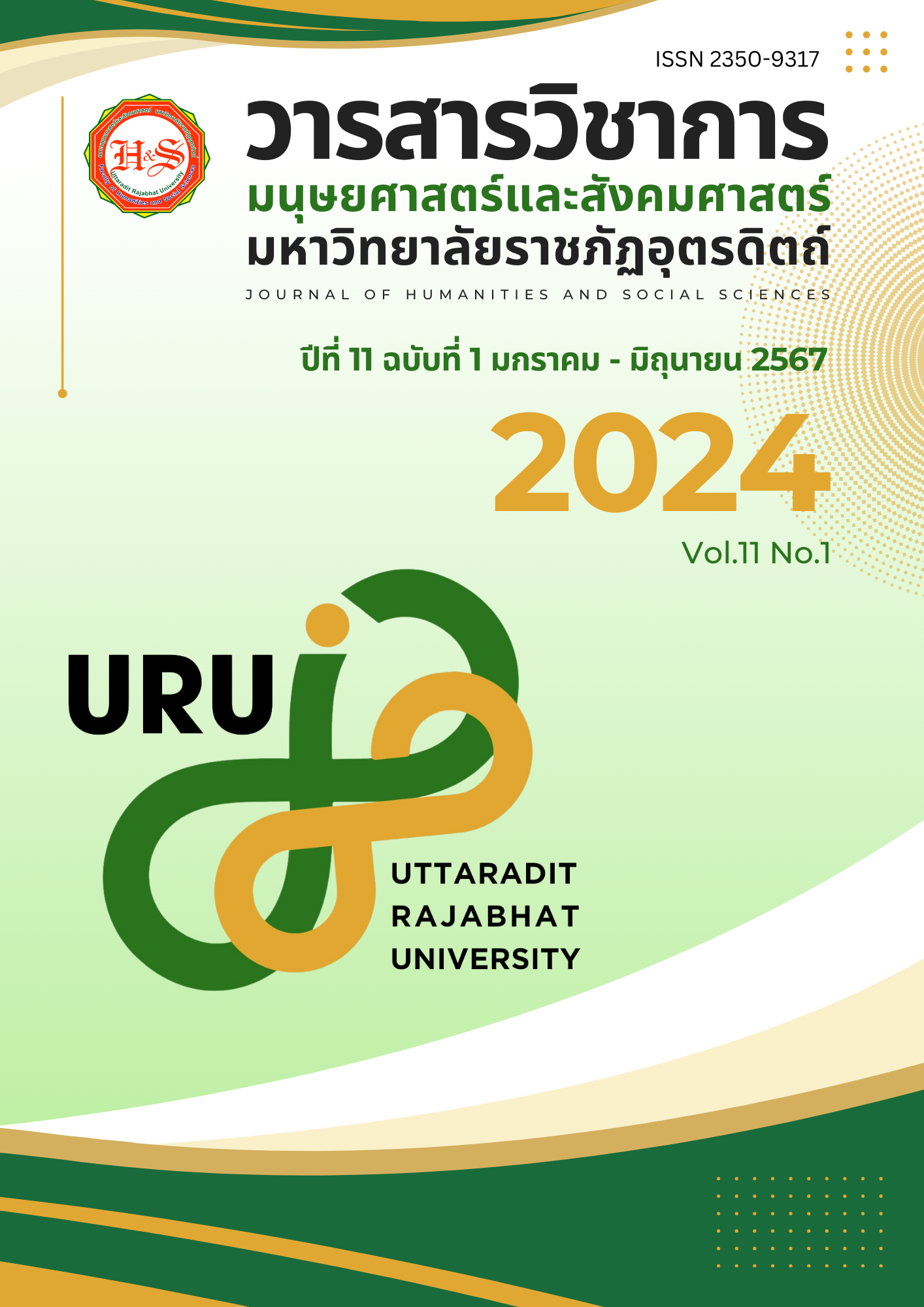The Study of Beliefs in the Naming of Ancient Chinese Wines
Abstract
The objective of the research was to investigate the beliefs that are reflected in the meaning of the words used in naming Chinese wines during the feudal period, from the Xia, Shang, and Zhou Dynasties (2070 BC - 221 BC) to the Qing Dynasty (AD 1636 - AD 1912), approximately 4,000 years, by using document data obtained from the National Wines History Research Center of China, total 578 names. The results of the study revealed that there were 179 names reflecting ancient Chinese beliefs which could be categorized into 4 aspects. The first aspect was beliefs about auspiciousness, including auspicious seasons, auspicious numbers, auspicious plants, auspicious objects, and auspicious meanings. The second aspect was the names of ancient Chinese wines conveying notions about purity and symbols such as ice, dew, lotus, white color, and clearness. The third aspect was the names of ancient Chinese wines depicting beliefs about nature, including mountains, pine trees, and chrysanthemums. Finally the fourth aspect was the names of ancient Chinese wines indicating ideas about Taoist beliefs.
References
กิ่งแก้ว เพ็ชรราช. (2545). เอกสารคำสอนคติชนวิทยา. สถาบันราชภัฏอุตรดิตถ์.
ประเสริฐ รุนรา. (2557). พิธีสวดนพเคราะห์: พลวัตของพิธีกรรมประดิษฐ์ในสังคมไทยปัจจุบัน [วิทยานิพนธ์ปริญญาเอก, จุฬาลงกรณ์มหาวิทยาลัย]. ฐานข้อมูลงานวิจัย (ThaiLis).
พระคงศักดิ์ สิริคุตโต (หมั่นวิชา). (2560). ความเชื่อและพิธีกรรมที่มีต่อประเพณีงานบุญบั้งไฟของชุมชนบ้านธาตุตำบลบ้านธาตุ อำเภอเพ็ญ จังหวัดอุดรธานี. มหาวิทยาลัยมหาจุฬาลงกรณราชวิทยาลัย.
ราชบัณฑิตยสถาน. (2556). พจนานุกรมฉบับราชบัณฑิตยสถาน พ.ศ. 2554. (พิมพ์ครั้งที่ 2). นานมีบุ๊คส์พับลิเคชั่นส์.
รี วอนบก. (2561). รอบรู้ทุกเรื่องไวน์ [The world of Wine] (นริศรา ไตรบุตร, ผู้แปล). นามมีบุ๊คส์. (ต้นฉบับพิมพ์ปี ค.ศ. 2008)
ศศิปรียา ปาคำน้อย. (2561). การศึกษาพิธีกรรมการเลี้ยงผีเสื้อบ้านของกะเหรี่ยงปกาเกอะญอบ้านป่างิ้ว ตำบลทาเหนือ อำเภอแม่ออน จังหวัดเชียงใหม่. [การค้นคว้าอิสระ, มหาวิทยาลัยราชภัฏลำปาง]. ฐานข้อมูลงานวิจัย (ThaiLis).
ศิรินทิพย์ มีสุขอำไพรัศมี. (2545). ปัจจัยที่มีอิทธิพลต่อพฤติกรรมการบริโภคเครื่องดื่มสุราแช่ผลไม้ของสตรีวัยทำงานในเขตกรุงเทพมหานคร. มหาวิทยาลัยศรีนครินทรวิโรฒ.
สุรชัย ชินบุตร. (2553). การสืบทอดอำนาจศักดิ์สิทธิ์ของหมอเหยาและอัตลักษณ์ของผู้ไทในพิธีเหยาเลี้ยงผี: กรณีศึกษาตำบลโนนยาง อำเภอหนองสูง จังหวัดมุกดาหาร. [วิทยานิพนธ์ปริญญาเอก, จุฬาลงกรณ์มหาวิทยาลัย. ฐานข้อมูลงานวิจัย (ThaiLis).
Dai, Y. (2011). The Study of Numeral Auspicious Talk in Chinese. Yangzhou University.
Guo, S. & Liu, X. (2009). Historical and Geographical Research of the Betelnut Planting and Betelnut Custom Culture in China. Journal of Chinese Historical Geography. 14(6), 6.
Huang, K. (1999). Encyclopedia of Religion. (2nd ed.). Sichuan People's Press.
Huang, M. (2017). Cultural Interpretation of White Images in Qu Fu. Journal of Yueyang Vocational Technical College. 32(6), 11.
Lu, J. (1988). Dictionary of Qigong Traditional Terms. Sichuan Science and Technology Press.
Li, J. (2013). Taoist Non-action Doctrine and Artistic Spirit. Journal of Shangqiu Normal University. 29(4), 15.
Liu, L. (2021). Taoist Spring Culture-Sending Wu Shi Pond Water to the Roots. Journal of Zhoukou Normal University. 38(6), 53.
Li, X. & Dou, X. (2022). Study on the inheritance and development of jade culture in modern times. Journal of Art Market. 20(1), 76.
Liu, X. & Wang, B. (1991). Dictionary of Chinese Symbols. (2nd ed.). Tianjin Education Press.
Li, Z. (2009). The rhetorical of "spring" in Tang Dynasty Poetry. Times Literary Magazine. 14(6), 108.
Lin, Y. (2009). The Cultural Connotation of Chinese Character Chun (Spring). Journal of Guangzhou RAD D & TV University. 33(2), 48-50.
Liu, W. (2016). The discovery and discussion of the "Tianlu" bronze mirror in the Eastern Han Dynasty. Journal of Cultural Relics. 31(6), 65.
Ma, L. & Yang, W. (2012). The origin of ancient Chinese wine and its relationship with agriculture from archaeological discoveries. Journal of Wenbo. 28(4), 18-22.
Mao, Y. & Qin, Z. (2013). Coconut culture information resources collected. China Circulation Economy. 27(5), 6.
Mo, J. (2009). The Reason for Eating Jade of Taoist. Popular literature. 53(19), 141.
Pan, L. (2000). The "fish" culture in Chinese folklore. Journal of Qiqihar University. 28(5), 51.
Pan, L. (2023). Study on the characters in "The World Speaks New Language" from the origin of the word "Qing". Journal of Chinese character culture. 20(1), 80.
Qi, J. (2006). Research on Nelumbo Nucifera Planting and Its economic and Cultural values in Ancient China. Nanjing Agricultural University.
Ren, Y. (2006). "Jade" and Taoist belief in immortals. Chinese Taoism. 44(1), 47.
Shi, X. (2022). Teaching the cultural meaning of color in Chinese as a foreign language. Journal of Literary Education. 17(2), 46-48.
Xu, S. & Yuan, R. (2019). Dictionary of Chinese Wine Culture. International Culture Publishing Company.
Su, W. & Yi, L. (2012). An Analysis on Difference and Similarity of Digital Culture between China and Vietnam from the Digit “One”. Journal of Wenshan Institute. 25(2), 76-79.
Sun, W. (2012). An analysis of the Betel nut culture in Hainan. Culture Journal. 16(5), 163-164.
Wang, L. (2020). Research on the reconstruction and application of traditional cultural elements in product design. Beijing University of Technology.
Wang, J. (2017). Connotation in literature the idiom about "chun" (spring). Journal of Xichang College. 14(6), 85.
Yang, L. (2021). “Classic of Mountains and Seas” and the Culture of Chinese Jade. Sichuan Opera Journal. 33(10), 15-23.
Ye, S. (2015). "Unity of Nature and Humanity" from Jade Symbolism and Legends. National Arts. 30(1), 32.
Zhang, P. (2009). Discussion of Traditional Feeling Knot of Chinese Chrysanthemum Culture Appreciates Beauty Interesting Aspect. Northern horticulture. 32(8), 137.
Zhang, R. (2013). A Comparative Study of Numerical Cultural between Chinese and English from the Perspective of Cultural Vacancy. Xinjiang Normal University.
Zhang, X. (2020). Project of A study on carbon 14 chronology in the Xia, Shang and Zhou dynasties. Social Sciences Digest (Chinese Historical Dynamics). 41(4), 62-66.
Xie, M. (2001). Differences and Connections between the Taoist School and the Taoist Religion. Journal of Guangxi Public Security Management Cadres institute. 16(4), 28.
Downloads
Published
How to Cite
Issue
Section
License
Copyright (c) 2024 Journal of Humanities and Social Sciences Uttaradit Rajabhat University

This work is licensed under a Creative Commons Attribution-NonCommercial-NoDerivatives 4.0 International License.
บทความเป็นลิขสิทธิของคณะมส. มรภ อต.



